In the lead photo, Freddy Agabashian takes the Marion Chinetti Ferrari out for a test drive during the 1954 time trials. It failed to qualify.Credit: IMS Museum
1953
Ferrari was undeterred by the results of the 1952 Indy, for plans were made to compete in the 1953 Indy 500, and an initial entry for Ascari was given the number of 97. In addition, two of the 375s sold to American customers planned a comeback; Howard Keck’s car was entered as number 45, with no driver listed, and Johnny Mauro entered with his 375 and given the number 47.
The 1953 Ascari Ferrari, presumably the same chassis that was used by Ascari during the 1952 Indy 500, was returned to Maranello and was equipped with a special 250 engine. The car was given a new clutch, suspension, hubs, brakes, fuel tanks, fuel tank and oil cooler. According to some reports, at the time, a new frame was made by Gilco and was equipped with a double shock Houdailles in place of the standard single shocks.
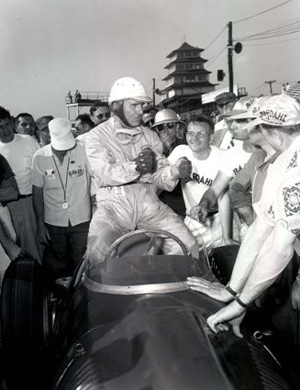
Indy, 1956. Farina in the 1954 375 Marion Chinetti car, describing how he successfully passed the rookie test. Credit: IMS Museum.
But it was the engine, designed in February 1953, that defined this car often referred to as the “Indianapolis 250”.Based on the engine of the 250 Europa, the V12 measured of bore and stroke of 68 mm for a total displacement of 2963.45 cm3. At one time it was thought (by Stan Nowak) that it had a “N” designation for “Nautical” but this was guesswork.
Equipped with single-stage compressor and Weber carburetors (they tried several types: IF4C Weber, and a 40, 46 and 42 DCF), it was bench tested at the end of September 1953; the engine reached an output of 500 hp at 7000 rpm, but the project was abandoned in favor of other industrial needs. (Some say the engine blew up causing an end to the project.) At some point, apparently this car was given the s/n 0388.
By way of comparison, the 250/I was tested with a 375 engine and it was the same engine that was later installed on the vehicle when it was delivered to Chinetti later on only to reappear at Indy yet again.
1954
In 1954, the 375-engined, ex-Ascari car was again entered in the Indy 500 after extensive modifications and strangely enough, booked in the name of Luigi Chinetti’s wife, Marion. The car was fitted with a body that took inspiration from the Ferrari Supersqualo 555 using side tanks. The tank on the left side contained fuel while the right contained an additional radiator for cooling the lubricating oil. This would hopefully redistribute the masses for improved handling on the banked oval. The car was tested by Fred Agabashian and Bobby Ball (a driver who had previously attempted to qualify a 375 in 1952), but none of the Ferraris entered actually qualified for the 1954 Indy 500.
The highly modified Ascari Ferrari had one more day in the headlines, as Nino Farina passed his rookie test in 1956 with the Marion Chinetti 375. Thereafter, the car stayed in the U.S. for many years.
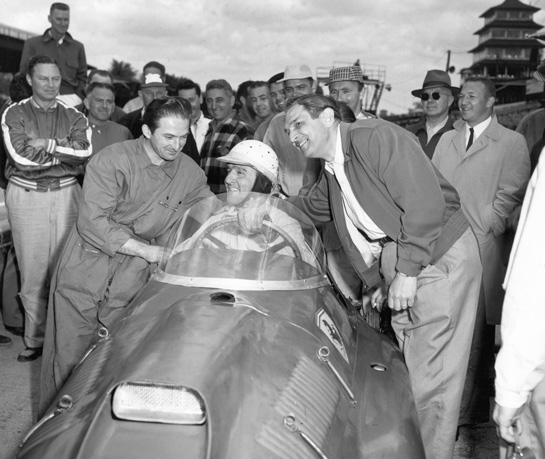
Farina is ebullient during his rookie test. The Ferrari mechanic on the right side of Farina..one of three sent over by the factory… is Stefano Meazza. He was with Ascari at Indy in 1952. Credit: IMS Museum.
[For a good detective story and its current whereabouts, try Google and the S/N 0388 or the most recent issue of Cavallino. Ed.]
1955-56
Ferrari’s last commitment to Indianapolis was for the 1955-’56 races. It was sponsored by BardahL, a company in Seattle, U.S.A. that produced additives to improve engine performance and had an Italian branch in Florence. This was to be a hybrid combing what some hoped would be the best of American and Italian technology.
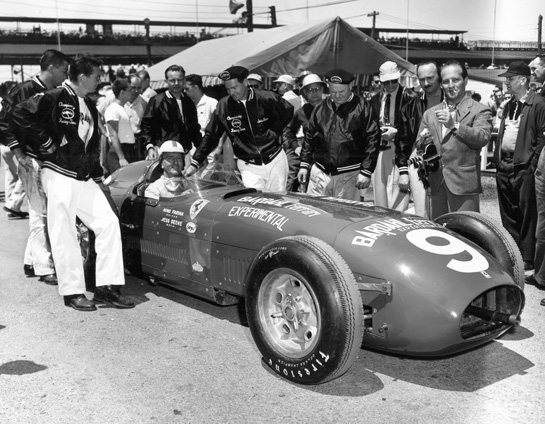
A real hybrid…a Kurtis chassis and a Ferrari six cylinder engine based on the type 121 engine eventually prepared by OSCA. Note the SF shields on the sides. Credit: IMS Museum.
It began in early ’55, when the Bardahl Company decided to buy a winning Indy car, purchasing Kurtis chassis No. 387 with full suspension and bodywork. It was then sent to Maranello for the completion of a very special car. The Kurtis was equipped with a version of the six cylinder in-line type 121, serial number 630 with a bore and stroke of 102 mm and 90 mm, for a total of 4412.492 cc. With a compression ratio of 10.3:1 and fed with a mixture consisting of 50% of gasoline Avio, 25% methanol and 25% of benzene through a battery of Weber DCO A3s, the engine was able to delivering 377 hp at 6000.
The Americans, aware of the problems previously encountered with Webers at Indy asked the Italian technicians to replace the carbs with the Hilborn injection system and to utilize methanol as a fuel. The Italians argued that they found that using the Hilborn injection had caused a decrease in power output of about 40hp. However, the injection was tested after a system modification made by Ferrari engineers led to the replacement of the injection pump, considered by Hilborn to be an unwise step.
The difficulties with the project and the problems of tuning of the engine caused the schedule to fall behind. Despite being registered with the number 47 and Nino Farina being designated as the driver, the car was not completed in time for the race of the 1955 Indy 500.
The car stayed in Italy and was later entrusted to Osca to complete the preparation. At the end of March ’56, Farina tested the chassis on the Monza circuit. Despite drawbacks, the engine was ready for April 26th, just in time to be mounted in the car in the Maserati brothers’ OSCA workshop.
The Ferrari-Bardahl Experimental arrived in Indianapolis on May 12, and was the car was given the number 9.
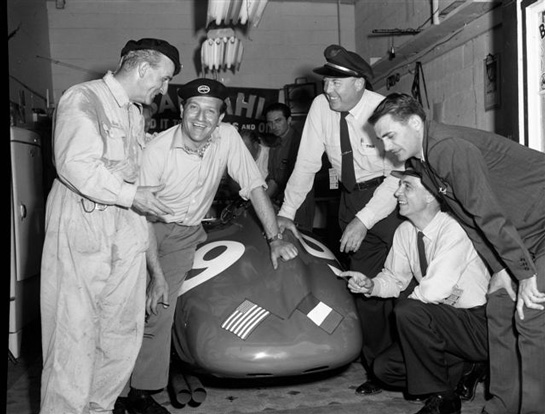
Over the Bardahl Special in Gasoline Alley, Nino Farina, left, jokes with the Americans for the cameraman, forgetting for a moment the tensions and problems that were to plague the last Ferrari attempt at Indianapolis. Credit: IMS Museum.
As mentioned, Farina had already passed the ‘rookie test’ with 375 number 91 entered by Marion Chinetti. The car, the same should have been used in ’54, was modified that year by omitting the right side tank containing the oil cooler.
In confirmation of the official support of Ferrari, three mechanics were sent to Maranello but Farina found great difficulty in adapting to the track.
Despite the changes introduced to improve the driveability and the power output, the engine was not able to exceed 6000 rpm. Again, not fast enough. After many modifications, the Bardahl Ferrari obtained laps of 220 kph, but to qualify it was necessary to obtain an estimated average between 223 and 226 kph.
Furthermore, it is notable that there were serious linguistic problems resulting in a great deal of misunderstanding between the Italian and American teams.
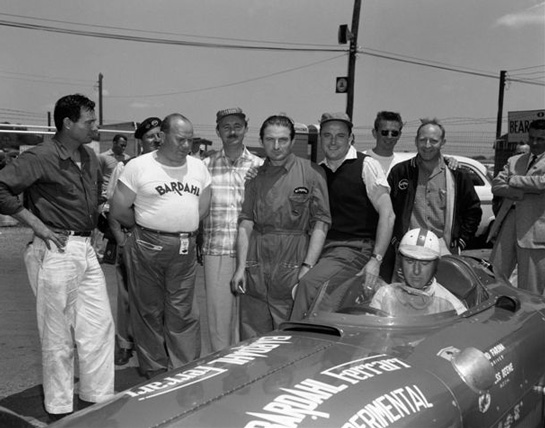
Unhappy group photo during qualifying as Farina could not get the car up to speed. A change back to the Hilborn fuel injection caused Farina to abandon all hope. Credit IMS Museum.
The Americans stepped in and replaced the carburetors on the engine with the Hilborn injection and adapted to methanol. According to Aldo Zana, ”Farina made a scene and he went to the Gasoline Alley shouting “Stop! This is enough!”
It was the last act of a story begun badly four years before. Ferrari was never to return to the Brickyard.
Thanks to Aldo Zana for his help and use of photos from his collection. Zana is an important Italian historian Journalist and an member of the AISA (Associazione Italiana per la Storia dell’Automobile).
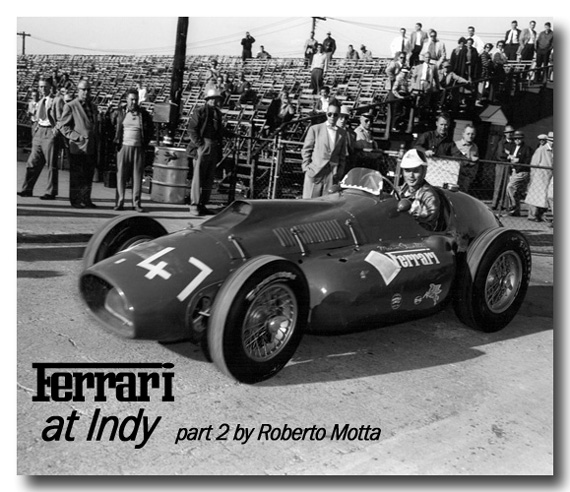
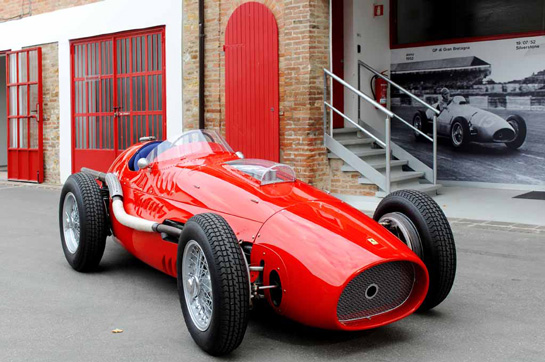
thanks a lot !
good article !
This is a wonderful story about the times when Indy was fun and inventive and not a spec car race of what may be the ugliest cars ever to put wheels on the ground.
This story is very interesting, but it has a few errors, in 1952 one of the Ferrari’s used fuel injection from Hilborn, I have over 200 images of the 1952 Indy race, at present my web-site is being updated, but Alberto Ascari was the only Ferrari that was able to qualify from the 4 Ferrari’s that tried to enter the race that year. Ascari was able to get into 7th place before his left rear wheel collapsed on the 40th lap. The other 3 Ferrari’s that had tried to qualify all failed. They were all private entry’s except #12 which was a factory entery, but Ferrari had sent over a group of mechanics to take care of the cars. Alberto Ascari was world champion in 1952.
Regards
Ron Kellogg